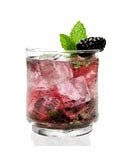I had totally forgot about it, until I was doing some research for my blog, I coincidentially run into some recipes from the Jerry Thomas´ Bartender´s Guide and so the mystery was solve. The lost name was a Gin Fizz but the difference was on the use of Sugar de Gomme or Gum Syrup.
A quick run to the Baking Goods Specialty Store in my hometown, saucepan, heat, patience and surprise!!, we have gum syrup to reproduce this refreshing recipe. My recommendation is to make a pitcher of it, because it will go fast.
Originally these drinks were called "Fiz", but now they inherited an additional Z, to be called Fizz (Maybe because sounds like a sizzle, much like the soda water hitting the acidic flavors). Fiz are regularly include in the Sour Type of drinks. But a Fizz don´t carry carbonated soda, I believe a Fizz is just are a different type of drink on its own. We could say that a Fizz is a Sour with a snap!.
Here I am posting three recipes. Jerry Thomas´ recipe, the traditional, and the modern one. Use the one you fill comfortable with and enjoy it.
Note: I will post a blog dedicated to the Ramos Gin Fizz, since this drink has many variations and its history is one that can be traced to its origins, it makes it a perfect candidate for a complete blog, just for you my Ramos.
Gin Fiz
The original Jerry Thomas recipe
- 1 tea-spoonful powdered sugar.
- 3 dashes of lemon juice.
- 1 wine-glass of Holland gin
- 1 small piece of ice.
- (Use medium bar-glass.)
I know you guys are wondering what the heck is the equivalent to a wine glass, so to make it easier, 1 wine-glass is the equivalent to 4 ounces. Additionally, just remember that in 1887, when Mr. Thomas was shaking "Gin Fizzes", ice was commercialized in Ice blocks, the now popular ice cubes became popular after the DOMELRE (Domestic Electric Refrigerator) made its appearance. So his reference to 1 small piece of ice, meant that is was a small chunk of ice equivalent to 2-3 ice cubes. Keep reading if you want the mistery of the Holland Gin to be dispersed.
Gin Fizz
Traditional Recipe
- 2 oz. Hollands Gin
- 1 oz. Fresh Lemon Juice.
- 1/2 oz. Gum Syrup*
- 2 1/2 oz. Soda Water
* check out my blog on how to make your own Gum Syrup
If by any chance you want to replace the Hollands Gin (a Dutch Gin know as jenever/genever) with your traditional London-type, nobody is ever going to say a word. For those of you, recipe chasers, Korenvijn is the closer you ever going to get to the original Hollands Gin. A popular brand is Rembrandt. Other valid replacements might include Oude (old) Jenevers. Bokma Oude Jenever wight be a viable option whenever you are in Europe since it is not easy to find in America. And if you just want to go crazy, try a Lemon Jenever with a very intense citrus flavor, A.V.Wess Citroenjenever might just do the trick.
Gin Fizz
Modern Recipe
- 2 oz. Gin
- 1 oz. Fresh Lemon Juice.
- 1/2 oz Simple Syrup
- Top with soda water
Bramble
Dick Bradsell´s Recipe
- 2/3 oz Gin
- 1/3 oz Fresh Lemon Juice
- 1/3 oz Sugar Syrup
- 1/3 Blackberry Liqueur (Chambord and Creme de Cassis are suitable replacements)
All these Fizzes will give you a pretty good reason to call up some friends and try some of these recipes. Enjoy them!.


































































